A New Health Assessment Index of Tunnel Lining Based on the Digital Inspection of Surface Cracks
Abstract
:1. Introduction
2. Theoretical Background
2.1. Concept of Tunnel-lining Crack Index
2.2. Concept of Fractal Dimension
2.3. Calculation Method of Fractal Dimension
3. Feasibility Analysis of Fractal Dimension as a New Health Assessment Index
3.1. Influence of Crack Density on the Fractal Dimension
3.2. Influence of Crack Width on the Fractal Dimension
3.3. Influence of Crack Distribution on the Fractal Dimension
4. A Case Study of Hidake Tunnel in Japan
4.1. Basic Condition of Hidake Tunnel
4.2. Digital Inspection Test
4.3. Results and Discussions
5. Conclusions
Acknowledgments
Author Contributions
Conflicts of Interest
References
- Yan, Q.; Zhang, C.; Lin, G.; Wang, B. Field monitoring of deformations and internal forces of surrounding rocks and lining structures in the construction of the Gangkou double-arched tunnel—A case study. Appl. Sci. 2017, 7, 169. [Google Scholar] [CrossRef]
- Soheyli, M.R.; Akhaveissy, A.H.; Mirhosseini, S.M. Large-Scale Experimental and Numerical Study of Blast Acceleration Created by Close-In Buried Explosion on Underground Tunnel Lining. Shock Vib. 2016, 2016, 8918050. [Google Scholar] [CrossRef]
- Li, W.; Xu, C.; Ho, S.C.; Wang, B.; Song, G. Monitoring Concrete Deterioration Due to Reinforcement Corrosion by Integrating Acoustic Emission and FBG Strain Measurements. Sensors 2017, 17, 657. [Google Scholar] [CrossRef] [PubMed]
- Malmgren, L.; Nordlund, E.; Rolund, S. Adhesion strength and shrinkage of shotcrete. Tunn. Undergr. Space Technol. 2005, 20, 33–48. [Google Scholar] [CrossRef]
- Aktan, A.E.; Catbas, F.N.; Grimmelsman, K.A.; Tsikos, C.J. Issues in infrastructure health monitoring for management. J. Eng. Mech. 2000, 126, 711–724. [Google Scholar] [CrossRef]
- Bhalla, B.S.; Yang, Y.W.; Zhao, J.; Soh, C.K. Structural health monitoring of underground facilities—Technological issues and challenges. Tunn. Undergr. Space Technol. 2005, 20, 487–500. [Google Scholar] [CrossRef]
- Wang, B.; Mo, C.; He, C.; Yan, Q. Fuzzy Synthetic Evaluation of the Long-Term Health of Tunnel Structures. Appl. Sci. 2017, 7, 203. [Google Scholar] [CrossRef]
- Gao, Y.; Jiang, Y.J.; Li, B. Voids delineation behind tunnel lining based on the vibration intensity of microtremors. Tunn. Undergr. Space Technol. 2016, 51, 338–345. [Google Scholar] [CrossRef]
- Gao, Y.; Jiang, Y.J.; Li, B. Estimation of effect of voids on frequency response of mountain tunnel lining based on microtremor method. Tunn. Undergr. Space Technol. 2014, 42, 184–194. [Google Scholar] [CrossRef]
- Jiang, Y.J.; Gao, Y.; Wu, X.Z. The nature frequency identification of tunnel lining based on the microtremor method. Undergr. Space 2016, 1, 108–113. [Google Scholar] [CrossRef]
- Hayashi, Y.; Imai, J.; Yoshiduka, M.; Suzuki, M.; Shigeta, Y.; Nakagawa, K. Restoration measures of tunnel experienced large deformation due to natural disaster. Doboku Gakkai Ronbunshu 2004, 756, 61–74. [Google Scholar] [CrossRef]
- Shigeta, Y.; Tobita, T.; Kamemura, K.; Shinji, M.; Yoshitake, I.; Nakagawa, K. Propose of tunnel crack index (TCI) as an evaluation method for lining concrete. Doboku Gakkai Ronbunshuu 2006, 62, 628–632. [Google Scholar] [CrossRef]
- Yamada, T.; Sano, N.; Baba, K.; Shigeta, Y.; Yoshitake, I.; Nishimura, K. Evaluation method for soundness of lining concrete by tunnel-lining crack index. Doboku Gakkai Ronbunshuu 2009, 65, 11–16. [Google Scholar] [CrossRef]
- Briggs, J. Fractals: The Patterns of Chaos; Thames and Hudson: London, UK, 1992; p. 148. ISBN 0-500-27693-5. [Google Scholar]
- Wang, J.; Ogawa, S. Analysis of dynamic changes in land cover based on landscape metrics in Nagasaki, Japan. J. Appl. Remote Sens. 2016, 11, 016022. [Google Scholar] [CrossRef]
- Harte, D. Multifractals; Chapman & Hall: London, UK, 2001; pp. 3–4. ISBN 978-1-58488-154-4. [Google Scholar]
- Wang, J.; Ogawa, S. Effects of meteorological conditions on PM2.5 concentrations in Nagasaki, Japan. Int. J. Environ. Res. Public Health 2015, 12, 9089–9101. [Google Scholar] [CrossRef] [PubMed]
- Bisoi, A.K.; Mishra, J. On calculation of fractal dimension of images. Pattern Recognit. Lett. 2001, 22, 631–637. [Google Scholar] [CrossRef]
- Bolliger, J.; Sprott, J.C.; Mladenoff, D.J. Self-organization and complexity in historical landscape patterns. Oikos 2003, 100, 541–553. [Google Scholar] [CrossRef]
- Yu, B.; Zhao, J.; Fang, K.; Tan, Y.; Ning, J. Rock strength evaluation during progressive failure process based on fractural characterization. Mar. Georesour. Geotechnol. 2016, 34, 759–763. [Google Scholar] [CrossRef]
- Tian, W.; Han, N. Evaluation of damage in concrete suffered freeze-thaw cycles by CT technique. J. Adv. Concr. Technol. 2016, 14, 679–690. [Google Scholar] [CrossRef]
- Xue, D.J.; Zhou, H.W.; Ren, W.G.; Zhao, B. Multi-fractal characteristics of joint geometric distribution of granite in Beishan. Rock Soil Mech. 2016, 37, 2937–2944. [Google Scholar] [CrossRef]
- Alves, L.M.; Chinelatto, A.L.; Grzebielucka, E.C.; Prestes, E.; Lacerda, L.A. Analytical fractal model for rugged fracture surface of brittle materials. Eng. Fract. Mech. 2016, 162, 232–255. [Google Scholar] [CrossRef]
- Xie, H.; Sanderson, D.J. Fractal kinematics of crack propagation in geomaterials. Eng. Fract. Mech. 1995, 50, 529–536. [Google Scholar] [CrossRef]
- Xie, H.; Sun, H.; Ju, Y.; Feng, Z. Study on generation of rock fracture surfaces by using fractal interpolation. Int. J. Solids Struct. 2001, 38, 5765–5787. [Google Scholar] [CrossRef]
- Huang, H.; Sun, Y.; Xue, Y.; Wang, F. Inspection equipment study for subway tunnel defects by grey-scale image processing. Adv. Eng. Inform. 2017, 32, 188–201. [Google Scholar] [CrossRef]
- Zhang, W.; Zhang, Z.; Qi, D.; Liu, Y. Automatic Crack Detection and Classification Method for Subway Tunnel Safety Monitoring. Sensors 2014, 14, 19307–19328. [Google Scholar] [CrossRef] [PubMed]
- Mandelbrot, B. How long is the coast of Britain? Statistical self-similarity and fractional dimension. Science 1967, 156, 636–638. [Google Scholar] [CrossRef] [PubMed]
- Mandelbrot, B. The Fractal Geometry of Nature; W. H. Freeman and Company: New York, NY, USA, 1983; ISBN 978-0-7167-1186-5. [Google Scholar]
- Falconer, K.J. Fractal Geometry: Mathematical Foundations and Applications; Wiley: Chichester, UK, 1990. [Google Scholar]
- Liebovitch, L.S.; Toth, T. A fast algorithm to determine fractal dimensions by box counting. Phys. Lett. A 1989, 141, 386–390. [Google Scholar] [CrossRef]
- Chen, Y.Q.; Lu, A.S.; Hu, H.P. Summary of image analysis method based on fractal. Comput. Eng. Des. 2005, 26, 1781–1784. [Google Scholar]
- Wu, X.; Jiang, Y.; Masaya, K.; Taniguchi, T.; Yamato, T. Study on the Correlation of Vibration Properties and Crack Index in the Health Assessment of Tunnel Lining. Shock Vib. 2017, 2017, 5497457. [Google Scholar] [CrossRef]
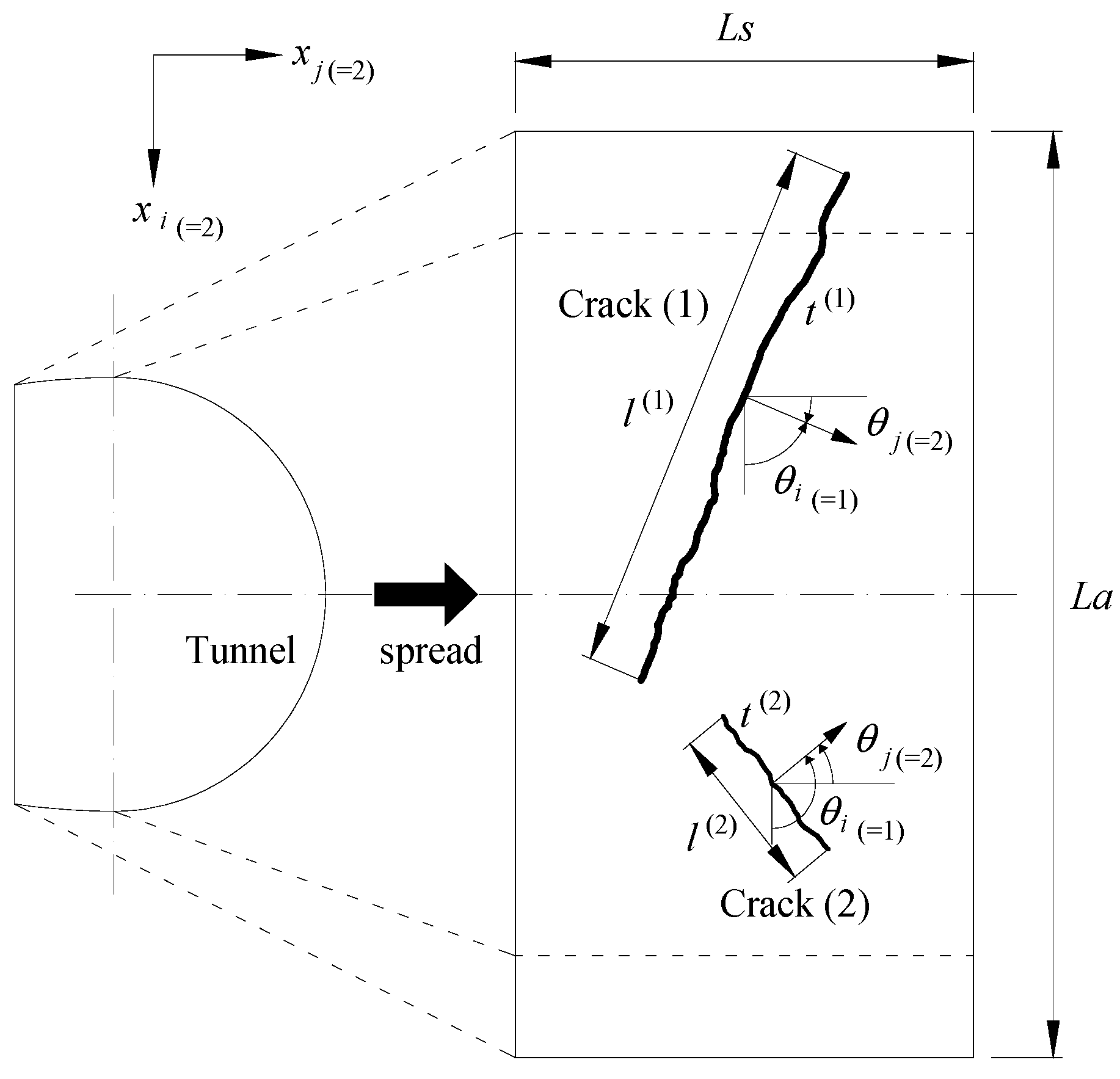

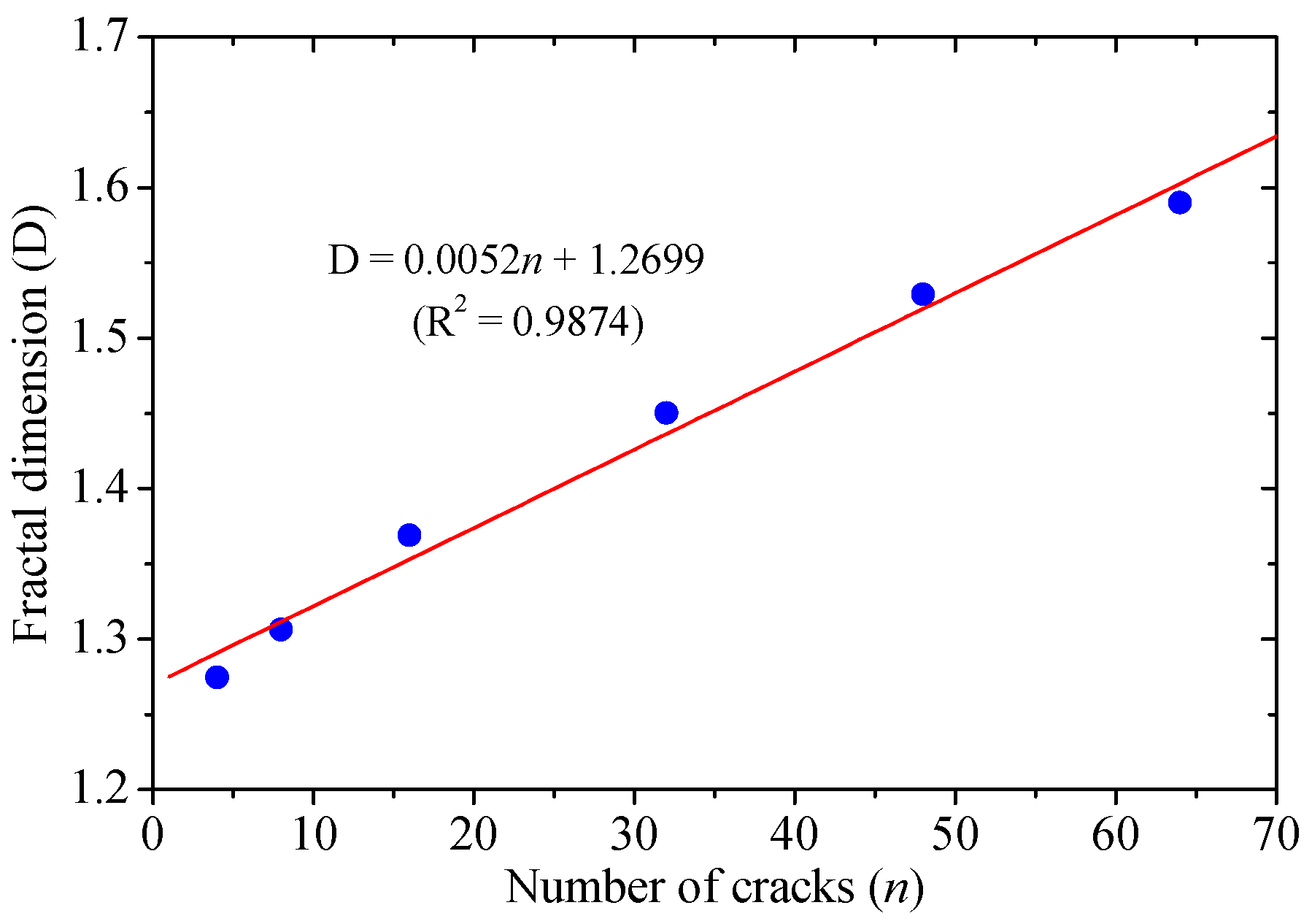
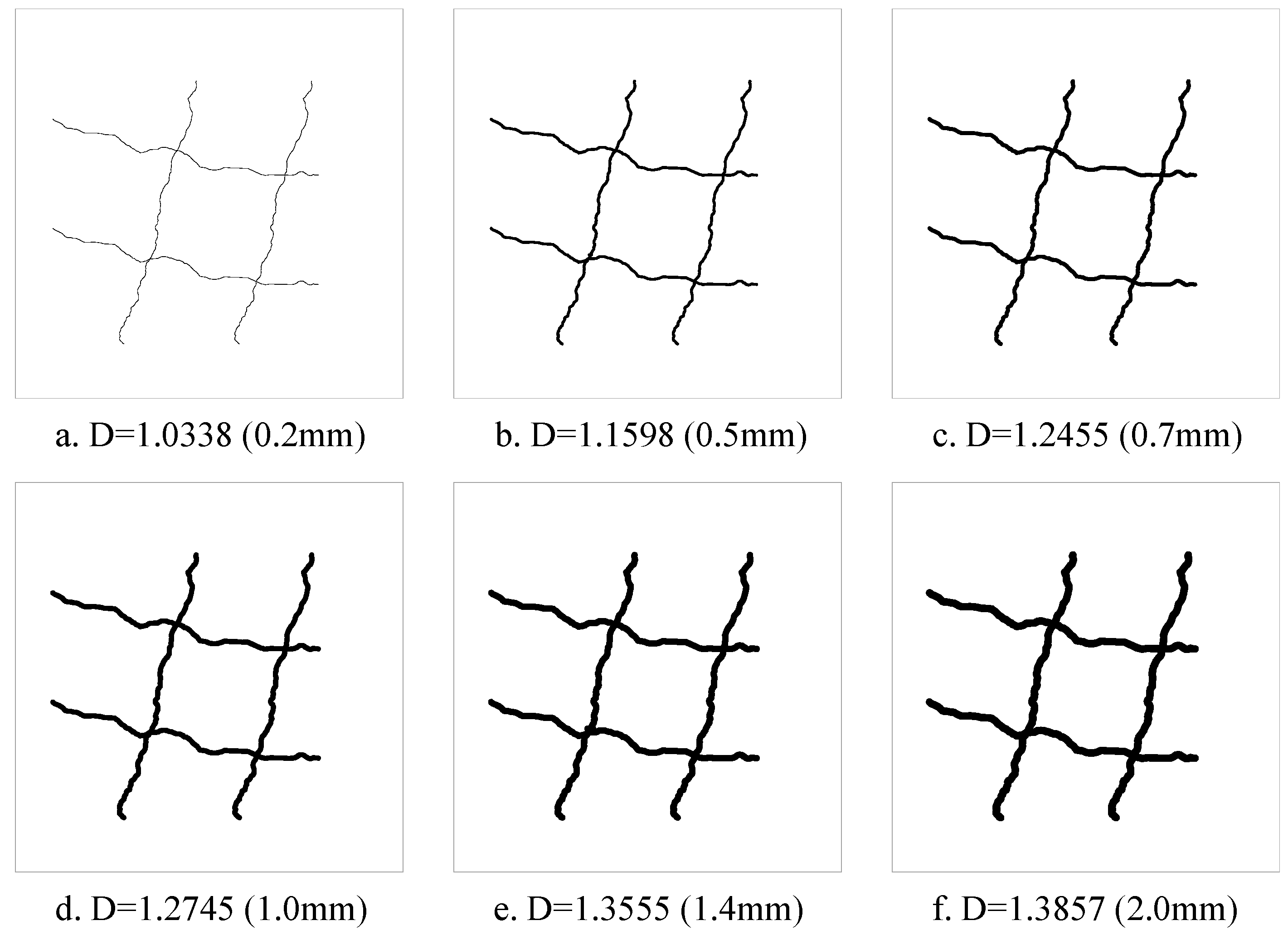
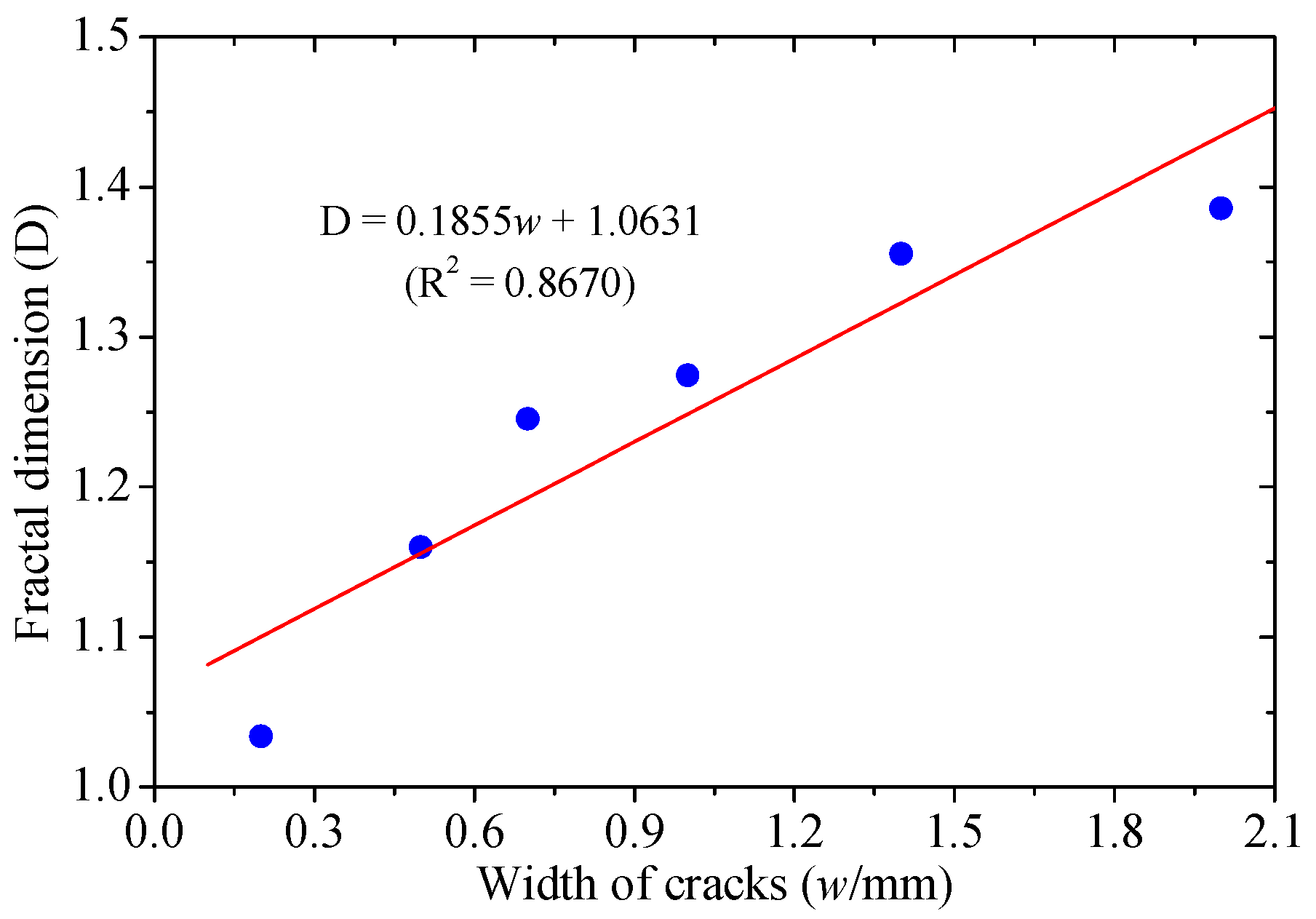
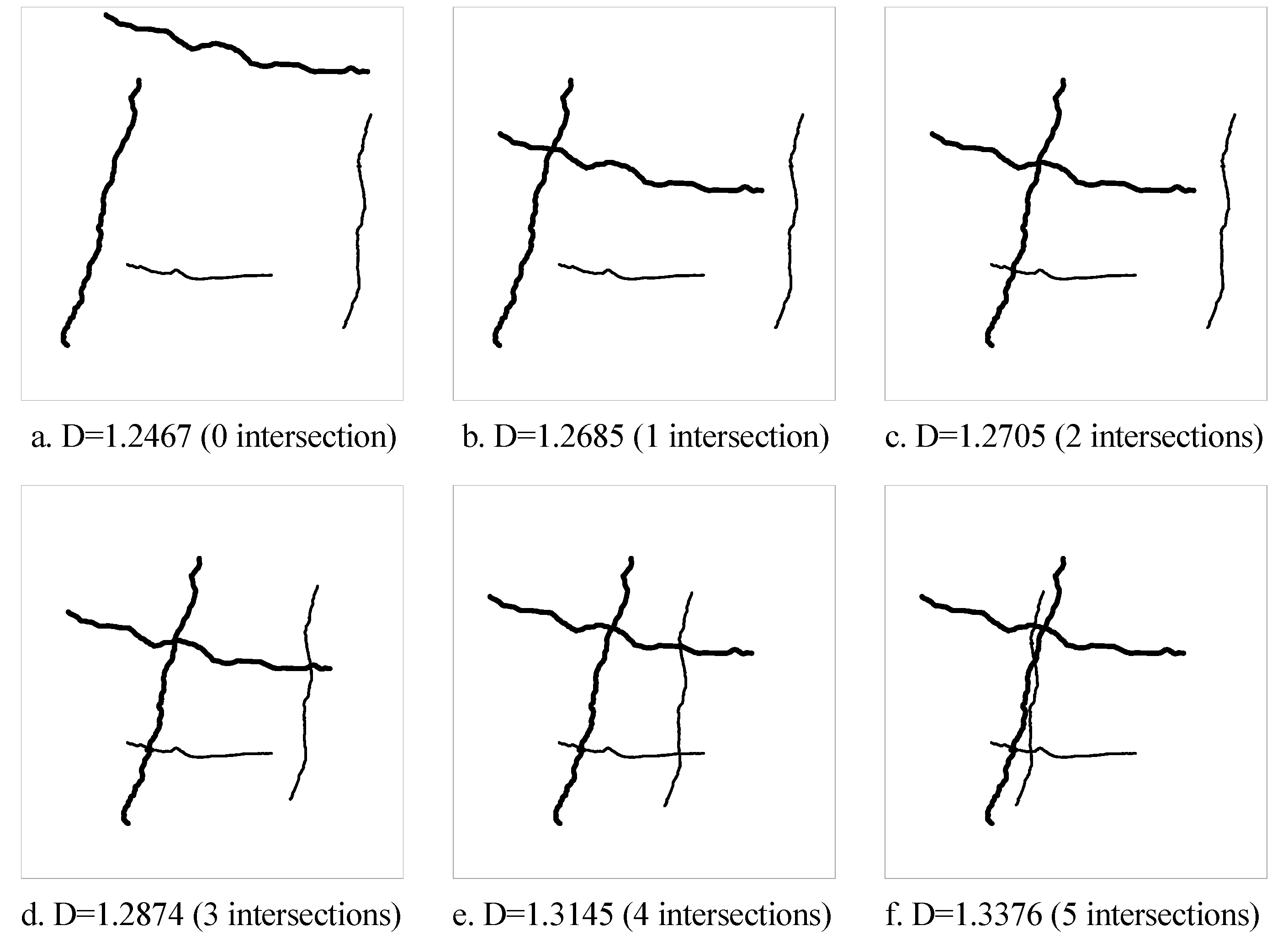
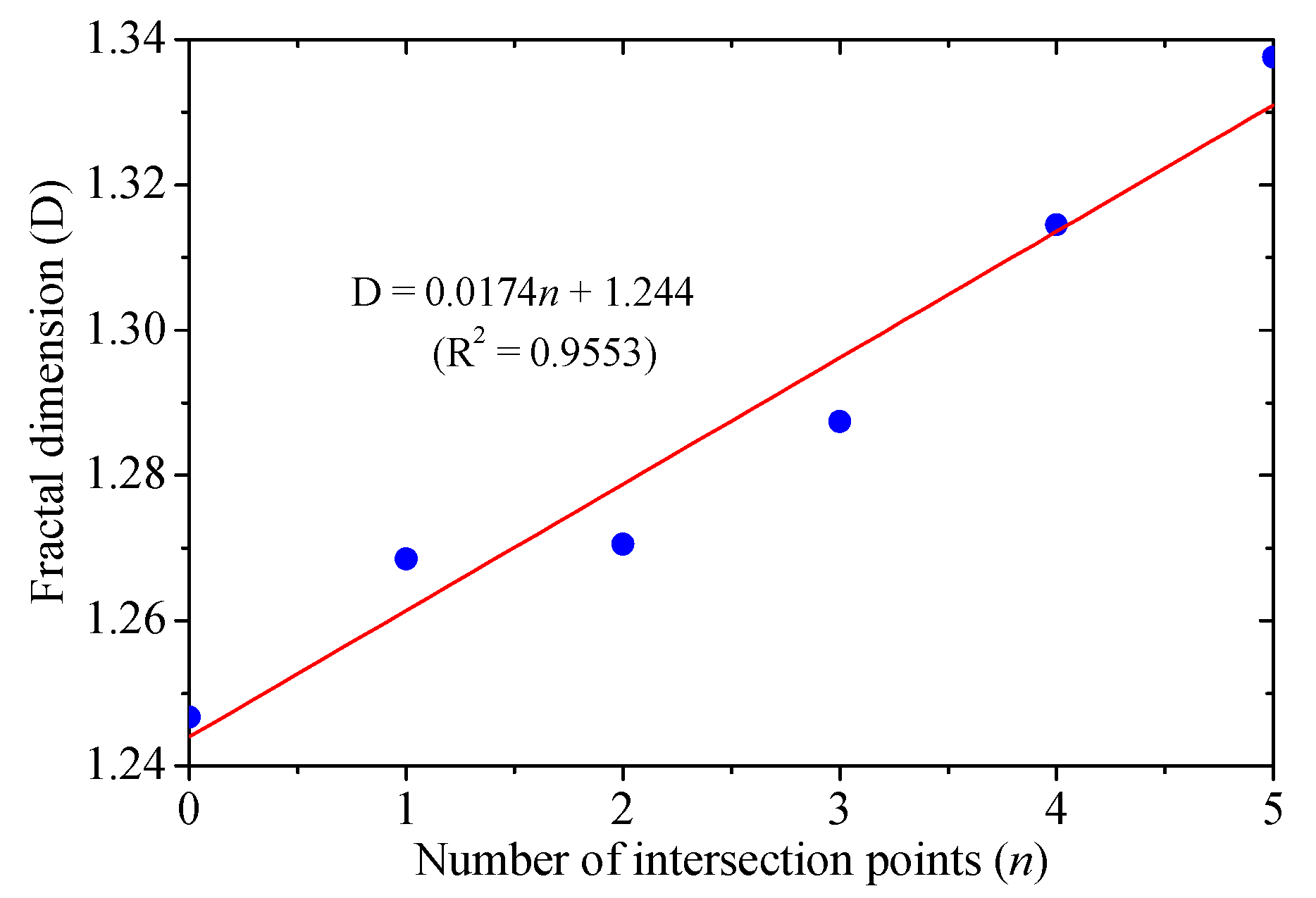
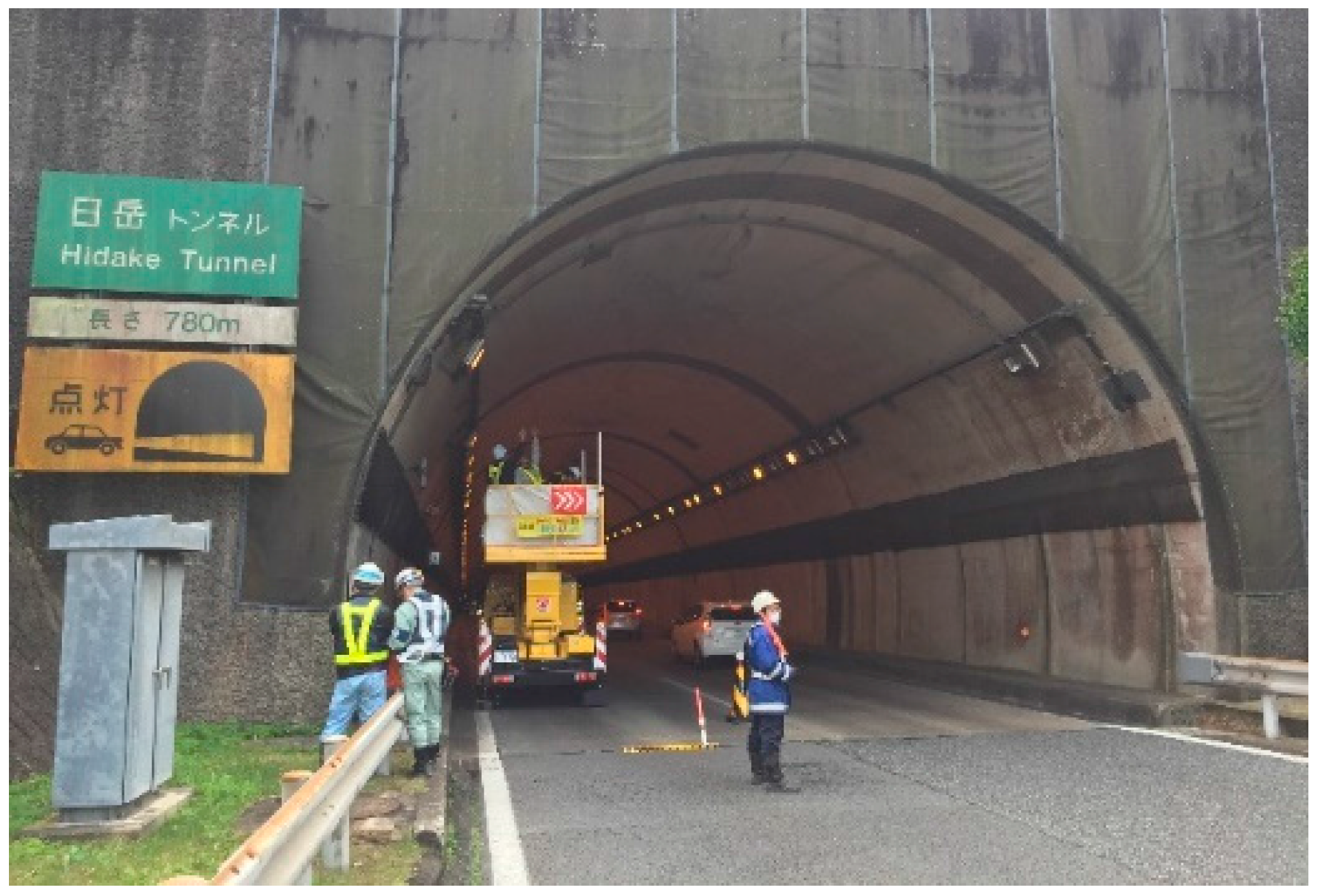
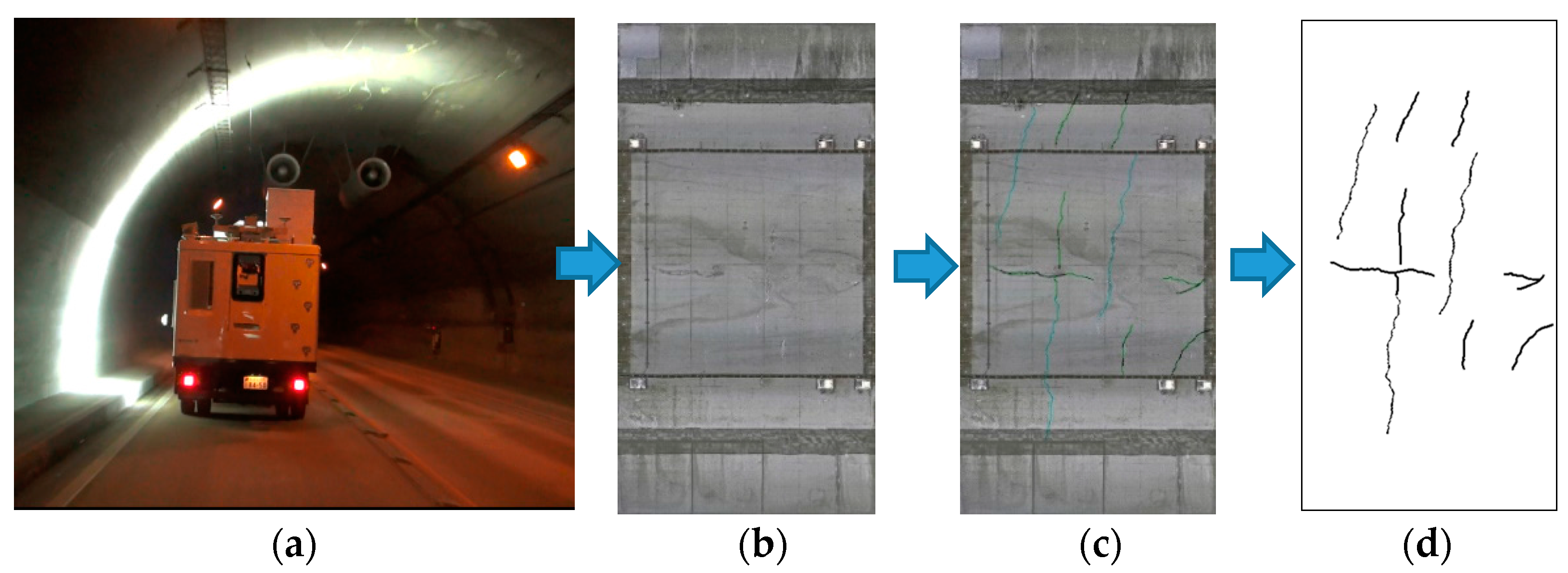
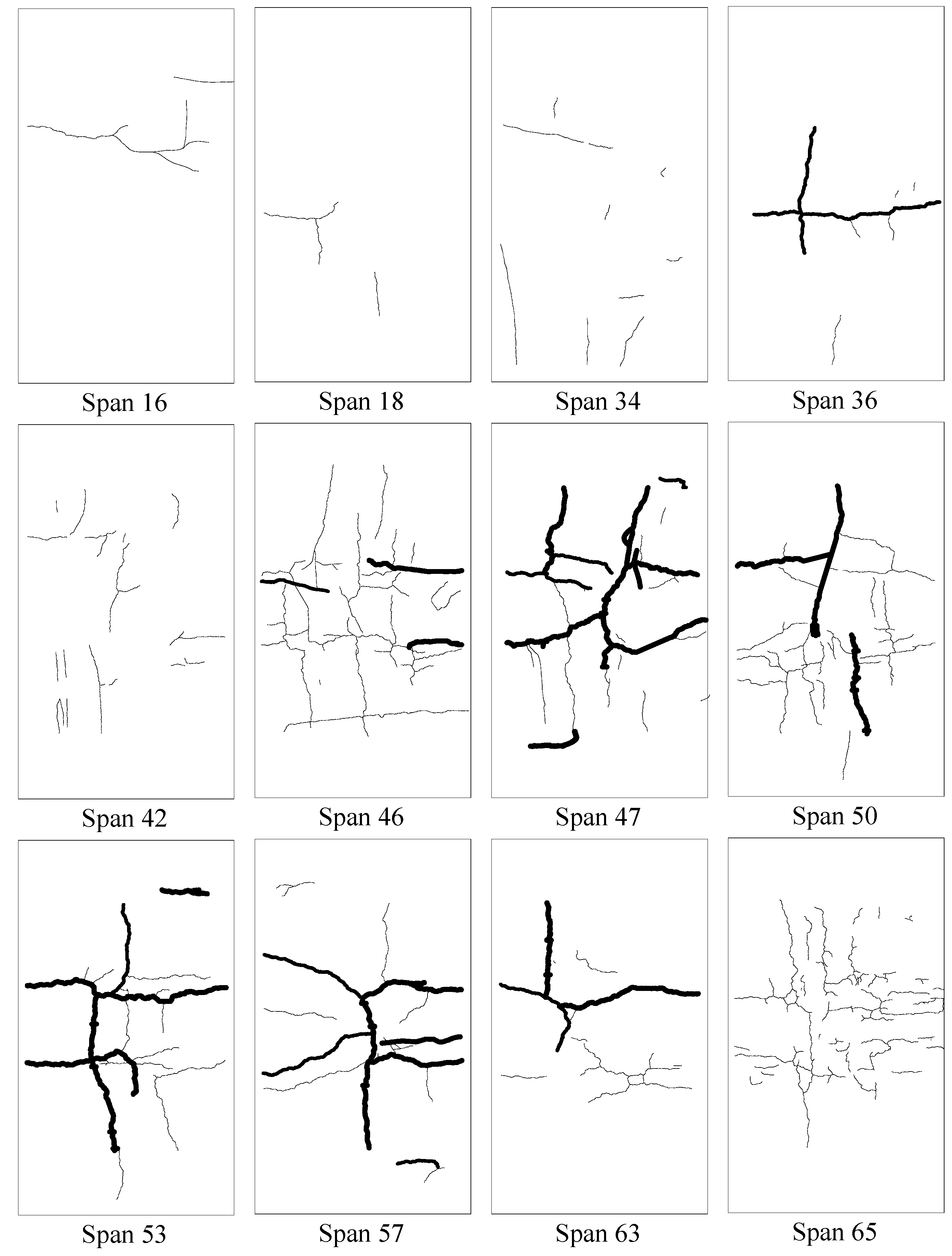
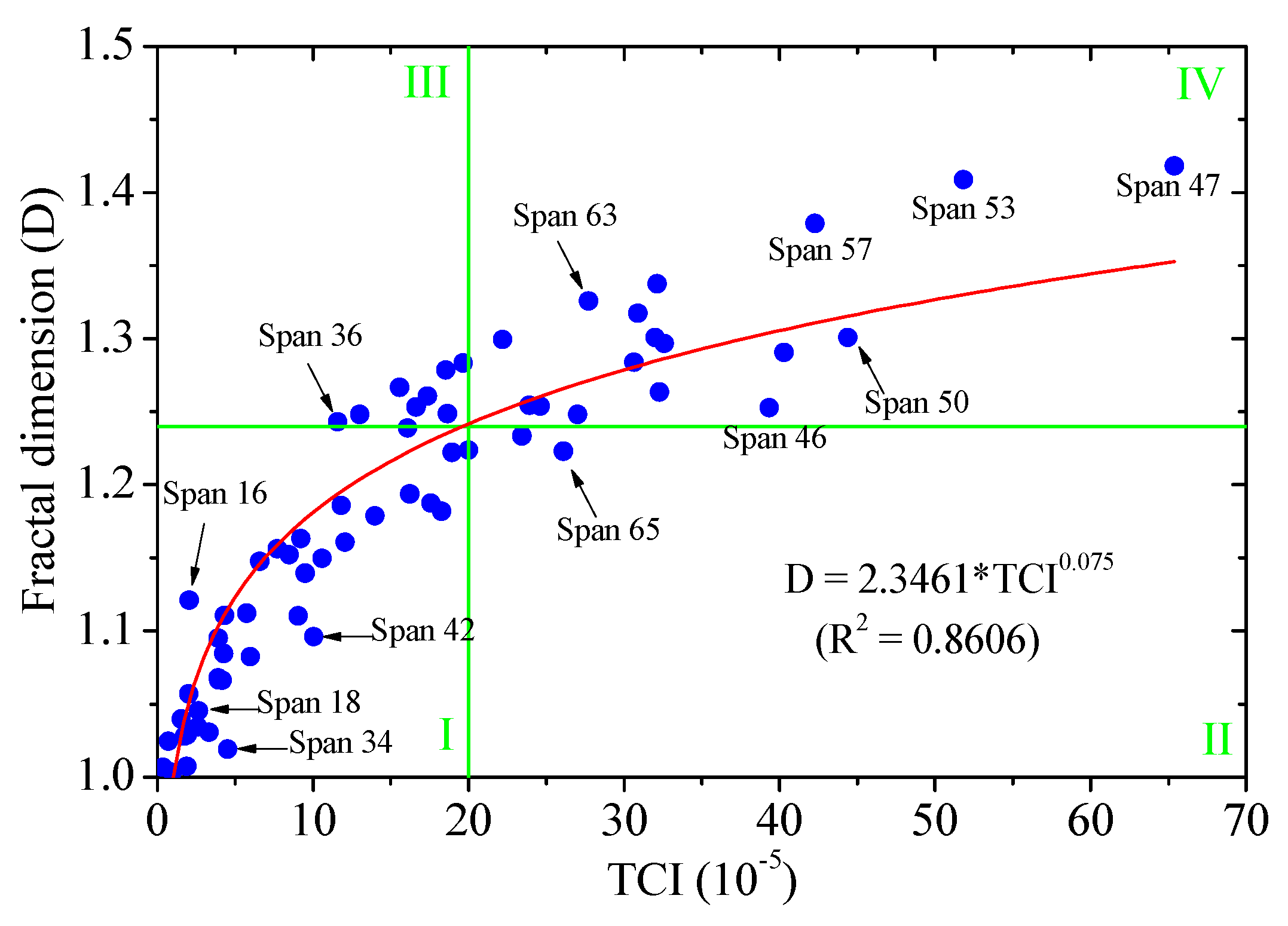
| Span No. | Lining Thickness | Inverted Arch | Buried Depth | Surrounding Rock Type | Surface Prep | Concrete Type | Construction Method |
|---|---|---|---|---|---|---|---|
| 16 | 0.55 m | No | 25 m | sand tuff | No | C20 | cast-in-place |
| 18 | 0.55 m | No | 25 m | sand tuff | No | C20 | cast-in-place |
| 34 | 0.70 m | No | 23 m | basalt | No | C20 | cast-in-place |
| 36 | 0.70 m | No | 23 m | basalt | No | C20 | cast-in-place |
| 42 | 0.55 m | No | 23 m | basalt | No | C20 | cast-in-place |
| 46 | 0.55 m | No | 23 m | tuff breccia | No | C20 | cast-in-place |
| 47 | 0.55 m | No | 23 m | tuff breccia | No | C20 | cast-in-place |
| 50 | 0.55 m | No | 23 m | tuff breccia | No | C20 | cast-in-place |
| 53 | 0.70 m | No | 23 m | lapilli tuff | No | C20 | cast-in-place |
| 57 | 0.70 m | No | 23 m | lapilli tuff | No | C20 | cast-in-place |
| 63 | 0.70 m | No | 2 m | lapilli tuff | No | C20 | cast-in-place |
| 65 | 0.70 m | Yes | 0 m | lapilli tuff | No | C20 | cast-in-place |
| Span No. | TCI (10−5) | D | Span No. | TCI (10−5) | D | Span No. | TCI (10−5) | D |
|---|---|---|---|---|---|---|---|---|
| 1 | 17.3533 | 1.2608 | 23 | 16.6357 | 1.2532 | 45 | 18.9605 | 1.2220 |
| 2 | 10.5798 | 1.1497 | 24 | 23.4324 | 1.2334 | 46 | 39.33 | 1.2527 |
| 3 | 9.5022 | 1.1395 | 25 | 18.5511 | 1.2783 | 47 | 65.3763 | 1.4182 |
| 4 | 9.2307 | 1.1630 | 26 | 15.5637 | 1.2665 | 48 | 32.1322 | 1.3375 |
| 5 | 9.0364 | 1.1102 | 27 | 18.6519 | 1.2487 | 49 | 40.2816 | 1.2906 |
| 6 | 0.9478 | 1.0031 | 28 | 22.1968 | 1.2994 | 50 | 44.3911 | 1.3006 |
| 7 | 13.9902 | 1.1786 | 29 | 3.9063 | 1.0679 | 51 | 19.656 | 1.2832 |
| 8 | 13.0135 | 1.2480 | 30 | 4.3127 | 1.1104 | 52 | 30.887 | 1.3173 |
| 9 | 12.0686 | 1.1608 | 31 | 4.2689 | 1.0844 | 53 | 51.8286 | 1.4087 |
| 10 | 16.0665 | 1.2386 | 32 | 6.5845 | 1.1474 | 54 | 32.2713 | 1.2633 |
| 11 | 7.7153 | 1.1560 | 33 | 3.3352 | 1.0306 | 55 | 32.0025 | 1.3007 |
| 12 | 3.9326 | 1.0665 | 34 | 4.5 | 1.0191 | 56 | 24.6288 | 1.2537 |
| 13 | 1.7505 | 1.0279 | 35 | 1.8892 | 1.0072 | 57 | 42.2909 | 1.3788 |
| 14 | 1.5339 | 1.0396 | 36 | 11.5899 | 1.2431 | 58 | 30.6416 | 1.2838 |
| 15 | 5.7424 | 1.1120 | 37 | 3.8941 | 1.0950 | 59 | 32.5696 | 1.2968 |
| 16 | 2.0397 | 1.1210 | 38 | 0.7143 | 1.0244 | 60 | 23.9007 | 1.2542 |
| 17 | 2.0151 | 1.0570 | 39 | 2.5996 | 1.0343 | 61 | 20.0143 | 1.2237 |
| 18 | 2.6453 | 1.0454 | 40 | 1.9042 | 1.0286 | 62 | 18.2604 | 1.1819 |
| 19 | 0.3402 | 1.0068 | 41 | 17.5861 | 1.1876 | 63 | 27.706 | 1.3257 |
| 20 | 4.163 | 1.0663 | 42 | 10.0495 | 1.0961 | 64 | 11.8213 | 1.1860 |
| 21 | 5.9599 | 1.0823 | 43 | 16.2336 | 1.1936 | 65 | 26.1172 | 1.2229 |
| 22 | 8.4668 | 1.1521 | 44 | 27.0087 | 1.2482 |
© 2017 by the authors. Licensee MDPI, Basel, Switzerland. This article is an open access article distributed under the terms and conditions of the Creative Commons Attribution (CC BY) license (http://creativecommons.org/licenses/by/4.0/).
Share and Cite
Wu, X.; Jiang, Y.; Wang, J.; Masaya, K.; Taniguchi, T.; Yamato, T. A New Health Assessment Index of Tunnel Lining Based on the Digital Inspection of Surface Cracks. Appl. Sci. 2017, 7, 507. https://doi.org/10.3390/app7050507
Wu X, Jiang Y, Wang J, Masaya K, Taniguchi T, Yamato T. A New Health Assessment Index of Tunnel Lining Based on the Digital Inspection of Surface Cracks. Applied Sciences. 2017; 7(5):507. https://doi.org/10.3390/app7050507
Chicago/Turabian StyleWu, Xuezhen, Yujing Jiang, Jianhua Wang, Kusaba Masaya, Tetsuya Taniguchi, and Takahide Yamato. 2017. "A New Health Assessment Index of Tunnel Lining Based on the Digital Inspection of Surface Cracks" Applied Sciences 7, no. 5: 507. https://doi.org/10.3390/app7050507
APA StyleWu, X., Jiang, Y., Wang, J., Masaya, K., Taniguchi, T., & Yamato, T. (2017). A New Health Assessment Index of Tunnel Lining Based on the Digital Inspection of Surface Cracks. Applied Sciences, 7(5), 507. https://doi.org/10.3390/app7050507






